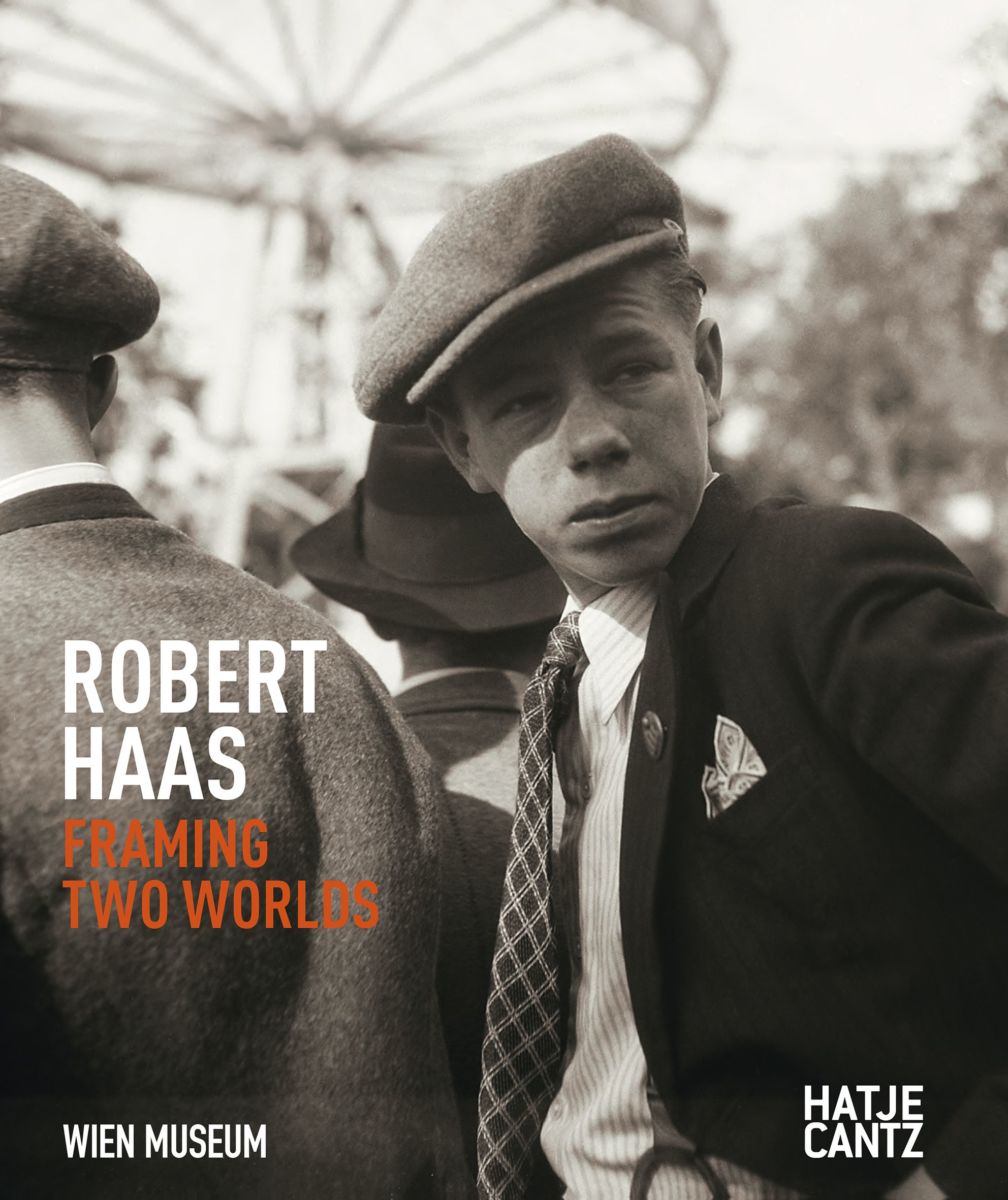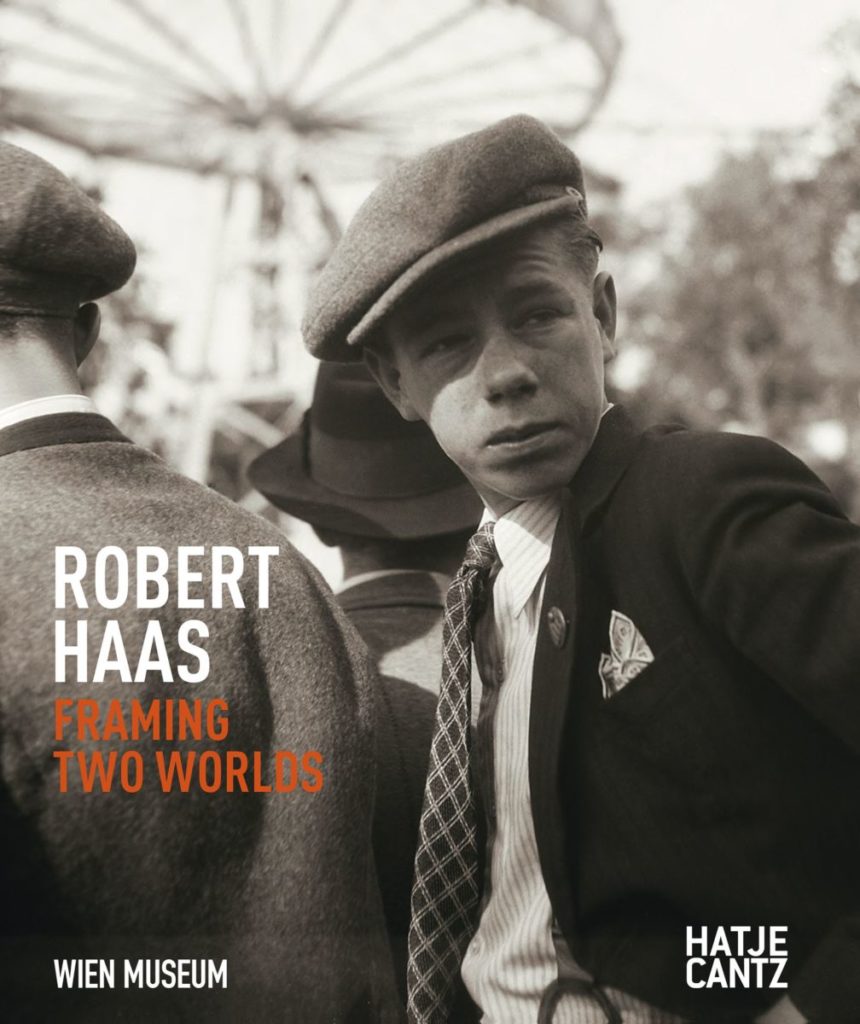
Book review of the Wien Museum exhibition catalogue
The Austrian-American photographer, graphic designer, printer of handmade books and typographer Robert Haas (1898-1997) was born in Vienna. He was forced into exile by the Nazis in 1938 and arrived in New York City the following year. Therefore, he was able to “frame from two worlds”, Austria and the United States.
Although he maintained his interest in photography in the Big Apple, photography “would no longer form part of his professional identity. This constituted a double loss: not only the extinguishing of Haas’s exciting artistic career in Vienna, but also his gradual abandonment of the medium of photography.”
The daughters of Robert Haas, Miriam Haas and Cathy Haas Riley, entrusted their father’s photographic archive to Wien Museum. In the fall of 2015, it was acquired by the Wien Museum Friends’ Association. It contains works of the Old and New World.
The archive of Robert Haas was “re-discovered” by the photography historian Anton Holzer. He discovered it while working on the Wien Museum exhibition about the Austrian studio photographer Trude Fleischmann.
The Wien Museum exhibition (until February 26, 2017) and catalogue contain some 200 works/illustrations. It is the first comprehensive exhibition of the artist’s body of work.
The photographs by Robert Haas span from social commentary and portrays of everyday life in interwar Vienna to images of the American way of life, street photography and portraits of emigrants like himself, including great artists such as Arturo Toscanini and Oskar Kokoschka as well as celebrity scientist Albert Einstein.
Biography of Robert Haas
Robert Haas was born in Vienna on April 16, 1898. He was the son of the Jewish, small textile wholesale businessman Daniel Haas (1866-1950), whose family came originally from Puchau in Slovakia, which was part of Hungary during the days of the Austrian-Hungarian Empire. Daniel Haas imported fine fabrics from France and sold them to middle-class customers and wealthy farmers in rural areas of Hungary.
The family of Robert Haas’ mother, Ernestine Haas, née Pick (1870-1939) came from Jungbunzlau in Bohemia. Robert had two brothers: the older, Paul (1896-1989), became a chemist, the younger, Georg (1905-1981), a zoologist and paleontologist.
The Haas family had a comfortable life until the Great War. They could afford a cook and another domestic servant. However, when war broke out in 1914, the father, a patriot, invested a large part of his saving in war bonds. At the end of World War I, they were worthless. The father had to fire his two domestic servants and was forced to work from home, giving up his office. The Austro-Hungarian Empire was split up and Hungary, his former sales region, had become an independent country. In the 1920, the galloping inflation made things even worse for the family.
After war service in the Austro-Hungarian army on the Romanian and Italian fronts from 1916 until 1918, Robert Haas studied electrical engineering at the Technische Hochschule Wien from 1918 until his graduation in 1924. In addition, he took classes in economic sciences, history, statistics and music at the University of Vienna. Furthermore, from 1918 until 1923, he studied typography and lettering with Rudolf von Larisch, who taught until 1920 at the Kunstgewerbeschule Wien and from 1920 at the Akademie der bildenden Künste.
Robert Haas began his artistic career as a graphic designer and printer in the Viennese Modernist circles of the 1920s. In 1922, he worked with Carry Hauser designing and printing a book by Hans Sachs. In 1925, together with Carry Hauser and Friedrich (Fritz) Siegel, he founded the Officina Vindobonensis art studio and print shop in Vienna. They designed and printed art books, brochures and other printed material, posters, book covers, ex libris, monograms and insignias. Their contacts during the interwar period included Adolf Loos, Josef Hoffmann, Marcel Breuer, Louis-Ferdinand Céline, Elias and Veza Canetti, Alfred Kubin and many others.
From 1927 onwards, Robert Haas exhibited design and calligraphic works in exhibitions in Cologne, Amsterdam, Vienna, London, Paris and elsewhere.
Robert Haas was over 30 when he embarked on his training with the well-established Viennese studio photographer Trude Fleischman, who became a lifelong friend. She was his teacher from around 1929 until 1931. Until then, as mentioned above, he had been working as a graphic designer and co-owner of an art printing business. Among his friends and acquaintances were the members of the Hagenbund, which included painters such as Franz Lerch, Georg Jung and Carry Hauser, as well as the Werkbund, with artists such as Clemens Holzmeister. In addition, he knew the influential art historian Heinrich Schwarz, who worked at the Österreichische Galerie in the Belvedere.
At the age of 12 already, Robert Haas had been given an ICA (Internationale Camera Actiengesellschaft in Dresden) camera with 9 x 12 cm negative plates by his father. Robert had used it mainly when the family traveled to visit relatives in Bohemia and Hungary and on trips to the Austrian Alps and to Italy.
The two years with Trude Fleischmann, Vienna’s leading studio photographer at that time, were not the end point of Robert Haas’ photographic career but rather the debut. After a return to graphic design, including a major order from the Kunsthistorisches Museum in Vienna in 1933, he took an increasing interest in photography. He preferred smaller mobile cameras such as a Rolleiflex and a Leica as well as natural light outdoors, which led him towards photojournalism. He captured street life and everyday scenes in Vienna and its surroundings.
In addition to numerous photographs made for newspapers and magazines, Robert Haas documented the Imperial Habsburg Collection of Arms and Amor at the Neue Hofburg and Museum für Völkerkunde in 1933-34. In 1935, he photographed the world famous Salzburg Festival. In 1937, he worked with architect Oswald Haerdtl, the designer of the Austrian pavilion at the Paris Exhibition of 1937, for whom he created the panoramic photomontage inside the pavilion. The same year, he finished a photo reportage of a steelwork factory in Donawitz in the Austrian region of Styria.
From 1934 until 1938 (after which the newspaper was banned), Robert Haas worked for Der Sonntag, the most innovative illustrated newspaper in terms of graphic design and photography.
At the end of September 1938, Robert Haas fled from the Nazi regime to London, where he spent six months working as a photographer and graphic artist. He completed a large-scale photo montage for the John Lewis & Co. department store.
On March 23, 1939 he sailed from London to New York City, where he arrived on March 28.
In 1939-40, he continued photographing, taking portraits of émigrés and their families in NYC and the surrounding areas. In 1940, he worked briefly as staff photographer for the regional newspaper Hartford News Daily. He taught photography, graphic design and art printing at progressive art colleges. He made a cross-country trip to teach at Hidden Villa Ranch in Palo Alto, California.
In 1941, Robert Haas founded the Ram Press art print shop in NYC. From 1941 onwards, he worked mainly as a printer, designing and printing books, posters, letterheads, insignias, invitation cards and brochures for customers such as the Guggenheim Museum the MoMA, Brooklyn Museum and the Frick Collection, for which he completed a large collection catalogue in 1949. In addition, he worked for galleries such as Galerie St. Etienne, the Betty Parsons Gallery, the Feigl Gallery and others. In addition, he made portraits and took pictures of everyday life in NYC and its surroundings.
In 1942-43, after the United States had entered the war in late 1941, as an “enemy alien”, Robert Haas was banned from taking photographs. However, he obtained an exemption for portraits and commercial photos. In 1943, he was rejected to join the U.S. Army as a war photographer due to age and health considerations.
On June 1, 1944 Robert Haas became a U.S. citizen. On May 8, 1945 he documented the end of World War II celebrations in an impressive photo series. He focused on portrait photography, taking pictures of Albert Einstein, Arturo Toscanini, Paul Robeson, Oskar Kokoschka and others.
In 1946, Robert Haas married the musician Maude Dabbs, whom he had met at Black Mountain College in 1940. In 1947 their honeymoon trip took them to Palestine, where his family lived, to Egypt and to Austria. Their two daughters, Catherine (Cathy) and Miriam, were born in 1948 and 1949.
In 1952, the family moved from NYC to Valhalla (NY). From 1954 until 1967, Robert Haas taught calligraphy and later typography at The Cooper Union for the Advancement of Science and Art in the East Village, NYC.
In the 1970s, he taught calligraphy and printing at Calhoun College and Jonathan Edwards College of Yale University in New Haven. In 1977, he taught calligraphy at the State University of New York at Purchase. From 1974 onwards, he taught at Fairleigh Dickinson University, Teaneck, New Jersey.
From 1983 until 1993, he mounted several exhibitions of his works in Austria, Germany and the USA (for instance in Vienna, Graz, Offenbach am Main, New Jersey and San Francisco).
In 1986, the Ram Press were liquidated and the archives were entrusted to the library of Fairleigh Dickinson University.
In 1993, Robert Haas received the Austrian Cross of Honor for Science and Art 1st Class. The following year, he re-acquired the Austrian citizenship.
Robert Haas died in Valhalla (NY) on December 5, 1997.

Leaving out quotation marks for easier reading, this article is entirely based on the book Robert Haas: Framing Two Worlds. Hatje Cantz, Wien Museum, November 2016, 200 pages, 219 images. Order the catalogue from Amazon.com, Amazon.co.uk and Amazon.de. Order the German edition, Robert Haas: Der Blick auf zwei Welten, from Amazon.de. The Vienna exhibition at Wien Museum ends on February 26, 2017. The book includes contributions by Anton Holzer, Frauke Kreutler and Ursula Storch as well as an introduction by Matti Bunzl.
English articles about hotels in Vienna: InterContinental Vienna, Hotel Sacher.